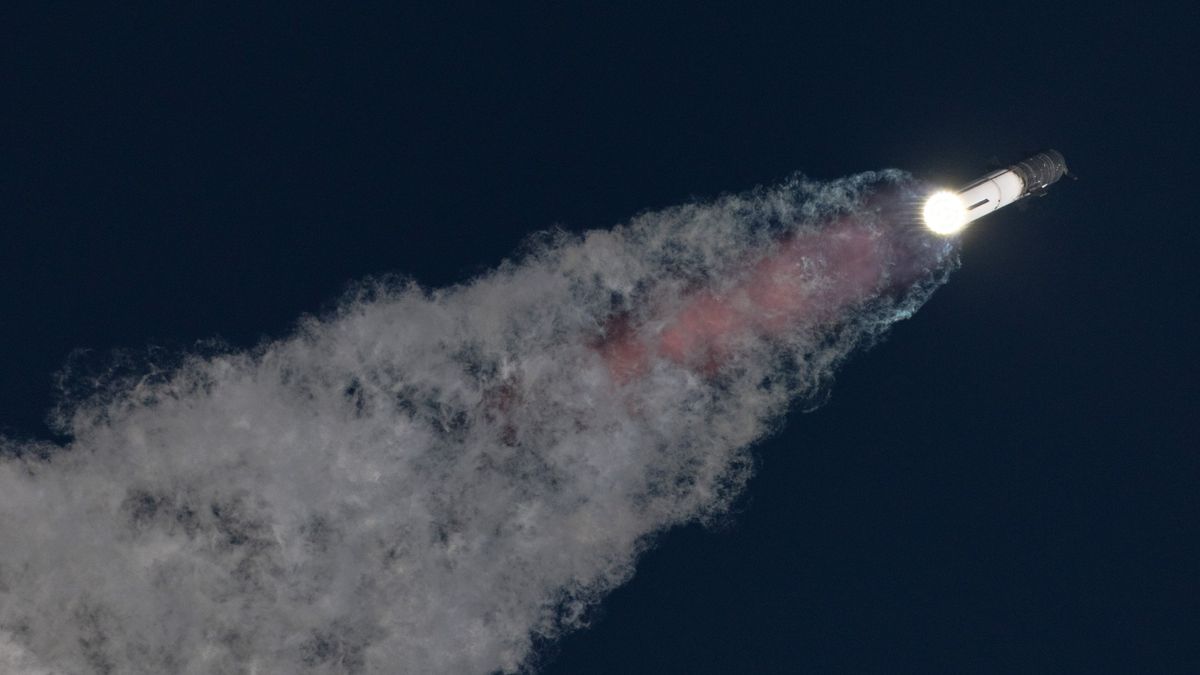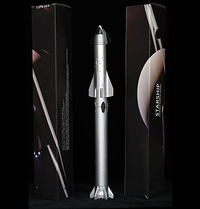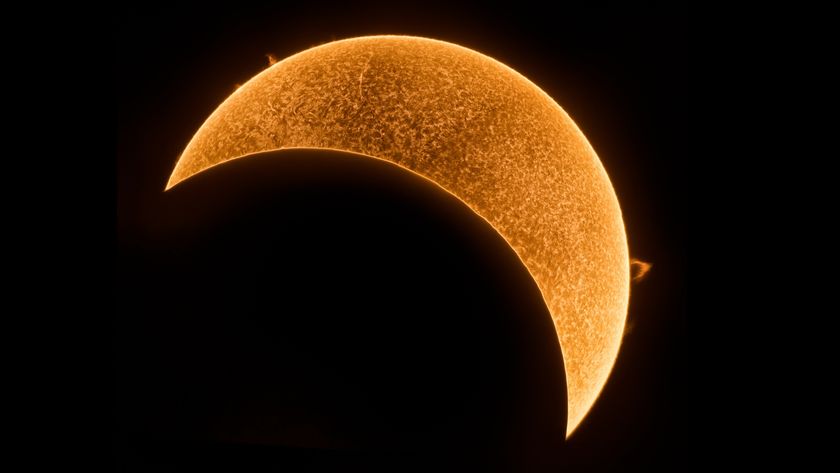
The second-ever test flight of SpaceX's giant Starship rocket has spurred an investigation, just as the first one did.
Starship lifted off from SpaceX's Starbase site in South Texas on Saturday (Nov. 18), kicking off a test mission that aimed to send the vehicle's upper stage most of the way around Earth.
The target was a splashdown in the Pacific Ocean near Hawaii about 90 minutes after launch. But Saturday's flight ended just eight minutes in, with the "rapid unscheduled disassembly" of Starship's upper stage. The U.S. Federal Aviation Administration (FAA) deemed this outcome a mishap and will supervise an investigation into its cause.
"The FAA will oversee the @SpaceX-led mishap investigation to ensure SpaceX complies with its FAA-approved mishap investigation plan and other regulatory requirements," the agency wrote via X on Saturday. There have been no reports of injuries or damage to public property as a result of the flight, the FAA added in another post.
Related: SpaceX's 2nd Starship launch test looks amazing in these stunning photos and videos
The FAA also oversaw the investigation that followed Starship's first test mission, which launched from Starbase on April 20. The vehicle suffered a number of problems on that flight; several of its 33 first-stage Raptor engines conked out early, for example, and its two stages — the Super Heavy booster and Starship upper stage — failed to separate as planned. As a result, SpaceX commanded a detonation of the tumbling vehicle, which occurred four minutes after liftoff.
That launch also damaged some of Starbase's infrastructure, blasting out a crater beneath the facility's orbital launch mount and sending chunks of concrete and other debris raining down on the surrounding area.
Get the Space.com Newsletter
Breaking space news, the latest updates on rocket launches, skywatching events and more!
The FAA closed that mishap investigation on Sept. 8, but other regulatory boxes still had to be checked before Starship could fly again. The agency finally granted a launch license on Nov. 15, after it had wrapped up a safety review and an environmental assessment.
Starship Die Cast Rocket Model Now $69.99 on Amazon.
If you can't see SpaceX's Starship in person, you can score a model of your own. Standing at 13.77 inches (35 cm), this is a 1:375 ratio of SpaceX's Starship as a desktop model. The materials here are alloy steel and it weighs just 225g.
Note: Stock is low so you'll have to act quickly to get this.
It's hard to imagine this second investigation, and the ensuing licensing process, taking so long, because a lot went right on Saturday.
For example, all 33 of Super Heavy's engines lit up upon ignition, and the booster separated successfully from the Starship upper stage as planned. Starship's six Raptors burned for an extended period, taking the spacecraft to a maximum altitude of 91 miles (148 kilometers), according to telemetry that SpaceX provided during its launch webcast. During the April 20 flight, Starship got just 24 miles (39 km) above the ground.
Indeed, SpaceX hailed Saturday's test flight as a success.
"Honestly, it's such an incredibly successful day, even though we did have a rapid unscheduled disassembly of both the Super Heavy booster and the Ship," SpaceX quality engineering manager Kate Tice said during the live webcast. (Super Heavy was supposed to splash down in the Gulf of Mexico about seven minutes after launch, but it exploded shortly after stage separation.)
"That's great," Tice added. "We got so much data, and that will all help us to improve for our next flight."
It's unclear when that next flight will take place; that depends on the outcome of the investigation, and how many adjustments SpaceX may need to make before the FAA clears Starship for liftoff once again.
Join our Space Forums to keep talking space on the latest missions, night sky and more! And if you have a news tip, correction or comment, let us know at: community@space.com.

Michael Wall is a Senior Space Writer with Space.com and joined the team in 2010. He primarily covers exoplanets, spaceflight and military space, but has been known to dabble in the space art beat. His book about the search for alien life, "Out There," was published on Nov. 13, 2018. Before becoming a science writer, Michael worked as a herpetologist and wildlife biologist. He has a Ph.D. in evolutionary biology from the University of Sydney, Australia, a bachelor's degree from the University of Arizona, and a graduate certificate in science writing from the University of California, Santa Cruz. To find out what his latest project is, you can follow Michael on Twitter.
-
Unclear Engineer I think the FAA is stretching its mission statement with this investigation. Calling a development test result a "mishap" seems to imply that if you don't meet all of your mission goals on every try of a development project, there is something wrong with the project implementation. Of course, that is B.S. The FAA's legal responsibility is to ensure public safety, both from accidents that involve the public commercially, such as commercial aircraft crashes, and development projects that could hurt the public with flying debris or chemical contamination from aircraft that do not involve humans as passengers or crew.Reply
I have no issue with the FAA looking into a perceived problem on the first flight with the Flight Termination System apparently not working as designed, because that could threaten the public if the system fails to destroy the rocket when it heads out of the planned trajectory.
But, explosions of rockets under development are anticipated events, which are planned to occur in a safe manner when they happen. So, unless the FAA has some reason to think that something violated the safety plan, rather than just failing to fulfill the fondest hopes of the developers, the FAA should not create any delays in the development process. I doubt that SpaceX needs any "help" from the FAA to figure out what went wrong and engineer solutions. -
billslugg The FAA definition of "mishap" from their website:Reply
"Aircraft Flight Mishap.b. A mishap occurrence associated with the operation of public or civil unmanned aircraft system that takes place between the time the system is activated with the purpose of flight and the time the system is deactivated at the conclusion of its mission, and in which any person suffers a fatality or serious injury, or in which the aircraft receives substantial damage."
A "rapid unplanned disassembly" qualifies as "substantial damage". -
billslugg Just as a side note, the Feds can make their own rules. There are at least two ways this can happen:Reply
- Congress establishes a law providing for a penalty for, say, "pollution" but does not specify any details. The law will say "the details are at the discretion of the Secretary". All that is required is to gin up a couple of numbers, put them in the Federal Register, take public comment maybe. Depends on how the law was written.
- All laws need interpretation. There is a lot of weasel room in how you go about determining if someone broke the law. I have had many interactions with law enforcement agencies at all levels here in the US and abroad. Without exception I have been forthcoming and polite. Never had the slightest problem with how I was treated. And I got let off of some whoppers. It all depends on what level of respect you show. Musk does not show much thus he is constantly in trouble. -
Unclear Engineer I think it is more like you said, "Musk does not show much thus he is constantly in trouble."Reply
That is not "good law". Not respecting a bureaucracy is not illegal. Having worked in a couple, I have seen things I did not respect, and I have seen bias against people whom I respected.
So, again, just mincing words is not an adequate justification for government intrusion into a development process. Their mission is to protect public safety. Unless the FAA can show a threat to public safety beyond what it has already approved, it is out-of-bounds, logically and ethically. Yes, I realize that lawyers will argue "the letter of the law", with different lawyers hired to specifically to reach opposite conclusions about what the law actually means. That is why juries of common people are used to reach actual verdicts - the hope is that they will use common sense. -
billslugg You are correct, "mincing words" is not justification for government intrusion into the developmental process. Your only option is to convince Congress to stop delegating specifics to Secretaries. If the law says they can use their discretion there is not really anything anyone can do about it.Reply
You are correct, there is no law against being a jerk. But if you are a jerk, the Feds will use their Congressionally bestowed powers to screw you to the wall. "Tell it to the judge" is what they'll say. Or maybe, "Why don't you write a book about that. You'll have lots of time where you're going."











